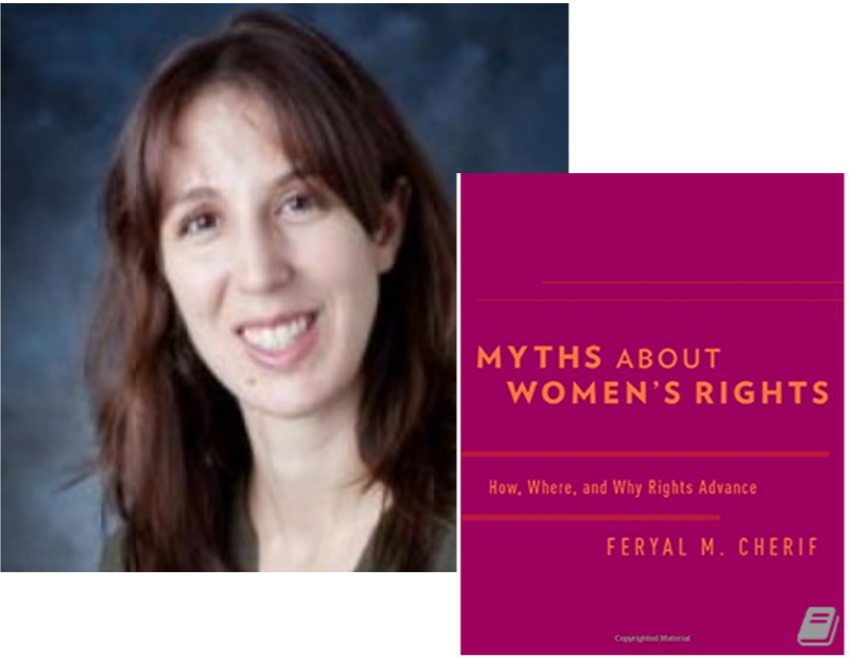
To honor the beginning of Women’s History Month this March, I recently interviewed Feryal Cherif, Ph.D., LMU associate professor of political science and international relations and director of the LMU International Relations Program. Her book, “Myths about Women’s Rights: How, Where, and Why Rights Advance” (2015), outlines a “core framework” on women’s rights. We explore Cherif’s framework of “core rights” and how women’s rights and interests shift over time, discussing recent examples. Cherif also discusses the processes necessary for women to advocate successfully for further opportunities today, and shares her “dream project” as she looks toward future research.

Sheri Castro-Atwater: When did you first come to LMU and what sparked your interest in exploring women’s rights?
Feryal Cherif: I first joined the LMU faculty in 2011, and my passion in exploring women’s rights was initially sparked by my mentor’s interest in human rights; under his guidance, I became knowledgeable and passionate about human rights issues broadly before turning my interest to understanding societal norms and how they change over time with respect to women’s rights. As a society, when do we change? And why do we change – what are the “push and the pull” factors? If there’s any question that kind of underscores all of what I do, it is really that question. Some social norms change rapidly; but even existing social norms, ones that we would argue are relatively stable, are just changing slowly over time. What do those processes of social change look like, and how do they change how we ultimately behave?
SC-A: Can you provide us with an example of what processes of social change might look like?
FC: One contemporary issue is when we examine the case of Iranian women, they have changed very markedly in their society. The Ayatollah decided to continue investing in education and that education has been for both men and women. And so, since 1979 they have produced a society of highly educated women, and then, for a set of functional reasons in 1989, they decided to re-introduce family planning. So suddenly Iran … had one of the most successful, if not the most successful, family planning program in the developing world, which meant that all of these Iranian women who were actually getting a decent education, at least by developing country standards, established social networks outside the home; their preferences and ability to organize changed and, and their ability to have a platform in which to demand changes within their society also changed. These policy changes — like family planning for women, expanding education for women, can have very diffuse effects. What we are seeing today is a product of changes that happened two decades ago that now have really come to bloom.
SC-A: This is a fascinating subject, and your book outlines the “core framework” necessary for women’s advancement. Can you describe what this is? How did you come to view women’s rights within this framework?
FC: I look at these rights — investments in education, but also the ability for women to actually work — as foundational rights. For me, they are the platform upon which other rights develop. So, if you want to think about it as a springboard, you can call these rights a springboard. Historically in the literature scholars have talked about the individual effects of women’s education, and the individual effects of women who work, and those would be things like professionalization and improved social economic status and the ability to have more bargaining power in the family. But I believe that all of those things kind of pre-existed what I call the “core rights” framework; these byproducts are really individual empowering effects or agency effects. The resources of education and labor force can be viewed as the “two pillars” by which these other agency effects blossom. Women develop networks that have social capital that they can tap into, and these networks become more valuable and more powerful as women advance in terms of socioeconomic status.
There are also some effects that I think we have been much more neglectful of in the literature, such as the effect of women now having a location that enables them to network with others, and the effect of women being more encouraged to engage in political activity. The locations themselves, these forums, for example, become powerful focal points for coordination and organizing. So, now women are more likely to talk about politics, to mobilize, to actually participate in the political landscape more broadly.
These are a few of the effects that happen collectively by virtue of women becoming educated and entering the workforce, so they are able to experience these other effects.
SC-A: How do these effects map on to women’s advocacy, or political agency?
FC: Well, I think another part of the story is that as women’s socioeconomic status improves, how they are perceived as a group changes, and politicians are going to be more likely to represent them, because they are more likely to represent people who are more powerful, more influential, and less marginalized. Whether right or wrong, politicians are going to be more responsive.
Educating women and encouraging them to enter the workforce also tend to be correlated with more egalitarian views among women. We find this happening even with women who were not predisposed to this orientation to begin with, and this tends to elicit more group consciousness. While women are not politically one cohesive group, we do observe that women have strong convergence over certain issues.
SC-A: So that brings us to where we are today: How is that being played out today in terms of where you see societies going, either internationally, or within the United States?
FC: Do I see “core rights” evidence in society today? I look to the current abortion debate in this country; it is astounding to me how passionate young women are, these women understand this as a woman’s rights issue and they share intense preferences. I do think this is largely due to being through a process where women as a group have become more and more empowered, and the idea that you can take away a right that has been looked upon as a basic right, and not activate such a group, is foolish.
SC-A: This prompts me to shift the focus now to looking at our own group, at women within academia. We know that women are still not only paid less, but that the support for women as working mother-scholars is sometimes not “front and center” or even existent at an institutional level. Though working mother-scholars can ask to “stop the tenure clock” for motherhood as a tenure-line professor, they cannot necessarily get that time back in terms of equal pay or opportunities. Obviously, as a group of mother-scholars, or women-scholars, we are not where we could be. What are your thoughts on this?
FC: I think the group “working mothers” is actually a perfect example of group consciousness. That subgroup consists of a large group of women, and workplace issues are perhaps the single largest concern over which there is group consciousness among women — and here at LMU and other institutions of academia, it is not simply because of childcare, not simply because of equal pay, but also, in academia, the great effort that goes into the career of a professor, in terms of time for research versus time spent on service or other activities that may be less valued by institutions of higher education. Putting these all together is more evidence of group consciousness, and yet we are not a formal group, in that we do not pay dues or have a label; we are an informal group. We are a constituency that exists, that has shared experiences and shared demands.
SC-A: You mention group consciousness and that we are not formalized; is that something that you would recommend? As part of the LMU Committee on the Status of Women, this is a question that we grapple with.
FC: I do not doubt it. I think that if there are “words of wisdom” per se that I could give, it would be that these investments are important, but they do take time to mature. Education and work are not enough. It is much more about all of the processes and potential connections that are inspired and ignited by these two pillars or “core rights.” In terms of a formal group, it is an interesting question that is worth pondering because on one hand, breaking into smaller, individual identity groups can go against this broader kind of cosmopolitan, or liberal progression that we may wish for or are supposed to want. Take for example, what American political scientists refer to as the “super educated” women, women with really intense abortion preferences; and yet, this issue has now become so important across a broad spectrum of Americans that it is probably enough to have an informal, latent kind of interest rather than to formalize this as a subgroup.
Yet on the other hand, organized interests are “squeaky wheels,” and, regardless of how parochial, they usually garner more deliverables. So, I do think to the extent that women want to see more policy changes that directly benefit them — especially for policy demands that are not a broad interest — the more formalized they may want to become. You will most likely need a much more narrow group to advocate on a specific issue and for a specific group.
SC-A: Excellent point. Going back to your research and relating it back to issues of the day, what are your “dream research projects” that are up next for you? What research questions would you like to pursue?
FC: I have now begun to focus more on women’s rights in Muslim-majority countries. My interest there is really one about change in the Muslim world, and for me, the real question is: What conditions help keep the status quo in place? In societies where women have strong “core rights,” my current interest lies in exploring this nexus between property rights and marriage practices.
In these societies, religiously, women are supposed to inherit (although they inherit less than men), and that inheritance has given rise to two problems. One is that fathers, husbands, and brothers will try to steal from women. But historically, courts have sided with women; there is evidence of women in various classes using the court system, the judicial system, to reclaim inheritance. But on the whole, most women do not go to court and, although it varies by place and time, these rights have been respected to some extent. But it creates another problem with land in particular, because if women inherit land but also marry out, then that land essentially becomes another’s land; it’s taken away from the family land. That land keeps getting split apart.
A creative workaround to this issue has been consanguineous marriage(marriage between descendants of the same ancestors, i.e., cousins) in order to keep the land within the family. If you encourage cousin marriage, women’s share of land is being kept within the family and capital accumulation is easier. For familiesto actually stay powerful, they really have to operate as corporate units, as singular units, in general. So, I am interested in the nature of property rights, both female property rights, but also succession rights and the incentives they create. These kind of tribal or extended kinship structures that continue to exist create these corporate-like family groups that largely reinforce patriarchal systems that replicate over time. These systems are not just damaging to women, but also very damaging to young men as it reinforces a system of patriarchy. There are economic incentives that are reinforcing a system of patriarchy, and while it is beginning to get chipped away, this process is happening very, very slowly. I think this is one part of the answer of “Why does inequality persist?” The answer is that there are these economic incentives that give rise to particular kinds of family structures which are highly conservative, highly patriarchal and that are in many ways self-replicating, and that is why these practices have been so stable over time.
SC-A: That is a fascinating set of questions to examine, I wish you success as you pursue this research. Thank you so much for your time Feryal, I appreciate it.
FC: It was very interesting to talk to you, I appreciate it as well.
DEI Buzz
Restorative Practices Training – Thursday, March 16 and Friday, March 17 from 9 a.m.-4 p.m. Co-sponsored by TRHT and the Provost’s Office. Spots are still available for faculty! Sign up here.



